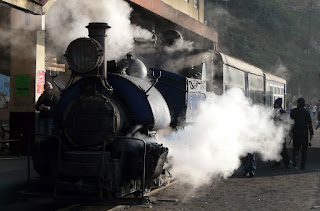Fortunately we did not have to spend too much time on looking for accommodation, since end of the tourist season (end of November) had left many hotels empty and hotel managers were ready to go down with the price quite easily.
Our hotel room however, was the coldest place we had to sleep in throughout all our trip.
It was so cold that when sitting in the room in the evening and breathing heavily, big cloud of water vapour came out of our mouths !
-------
Darjeeling is a so-called hill station, that was built actually quite recently, in 19th century after two British officers happen to stumble across a monastery nearby, found a peaceful forest ridge and passed word to Calcutta, that it could be a great place for sanatorium.
The face of Darjeeling is very British and compared to other Indian towns and cities, it is maybe one of the most pleasant and peaceful places. Especially in colder season, since it is too cold for most of the noisy Indian tourist then.




View from Darjeeling to the third highest peak of the world - Kanchenjunga (8586 m)
Due to massive influx of Gorkha labourers from Nepal in the end of 19th century, Gorkhas now make up the main population of Darjeeling, and their fellowship is so strong that they continuously put pressure on Indian Government to allow them to separate from West Bengal state and form new Indian state - Gorkhaland.


The western atmosphere in Darjeeling is very much created by old English architecture.
Also the central square is more common to European historical towns rather than to Indian cities. The central square of Darjeeling is a perfect place for sitting, observing people passing and other observers sitting nearby you or across the square.

Tibetan women resting and watching the people passing
The square is also the only open space that is good for playing football. And even though there are no real goals, litter bin and sleeping dog will do. And if it happens that the dog changes location, no problem, litter bin is easy to move as well....

kids playing football, having litter bin and dog as a goal
As we were walking on another peaceful narrow street of Darjeeling, we came across with a monkey family.


There was one small monkey that was sitting little farther from the rest of the gang on the fencepost and having the most saddest look you can ever notice on a monkey. He did not pay attention to any of the people who passed and took pictures of him, just sat there in his sadness.

Even the most sceptical human being who does not believe into the feelings of animals, would have noticed that something was really troubling that little fellow. Maybe nobody wanted to play with him or maybe he was put to sit on the fencepost by other monkeys as a punishment for something...
But most probably he had some other, monkey problems that we, humans, will never get to know about.

sad baby-monkey on his fencepost
As Darjeeling is situated in the foothills of Himalaya mountains, there is higher concentration of all kinds of Buddhist monasteries and temples.

Observatory hill - place for Buddhists, Hindus and very arrogant monkeys. It can be good to keep distance from monkeys there !

Buddhists Bhutia Busty Gompa with Kanchenjunga on the background

Bhutia Busty Gompa and monks painting wooden details in front of the gompa

Hindu cow and Buddhist monastery
Darjeeling is famous for tea.
Tea bushes were first brought to Darjeeling from Assam, since British wanted to find ways how to break China's monopoly over the tea trade.
Darjeeling produces now ~ 25 % of India's tea.
Happy Valley Tea Estate shows and explains to all visitors who are interested the different steps of processing tea. They ask no money for a little tour, but they appreciate if you give little donation - you may just give as much as you can, simply to thank the guide for the time he dedicated to you...
Unfortunately we picked not the best time to go to visit the factory, since it was Monday and on Sunday it is free day for tea collectors, so there was no tea in process at the moment.
But in general the tour through the factory was very interesting. We got to know many new facts about the tea science, including many other things for example that for the best quality tea, only the upper 3 laves of the whole bush are used and that the tea that is packed into tea bag is the lowest quality of all.
So, no tea bags in our home !

tea bushes

school path through the tea plantation

for drying tea leaves

for separating different quality tea

packing the tea
On one clear day we took a hike to nearby village Ghoom 8 km away from Darjeeling to see one more time the toy train, now from a different angle.

toy train in Darjeeling station

toy train on its way

Batasia loop, the most scenic part of the Himalayan railway, where the toy train makes a circle during which the altitude changes rapidly

view on Darjeeling
In the middle of one night, Branko's mobile alarm was ringing.
He had taken a challenge to go out of the warm sleeping bag into freezing dawn to take pictures of the first sun beams on Kanchenjunga.

Dawn at Kanchenjunga (8586 m)

Mahatma Ganhi was a wise man ! His quote in front of the Bengal Natural History museum
1 comment:
Especially good pictures this time!!!! both from the story-telling point of view and as quality shots in general!
Post a Comment